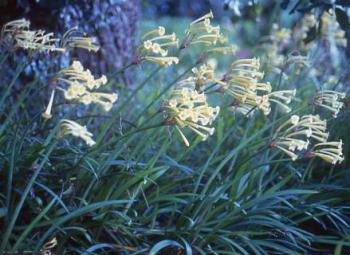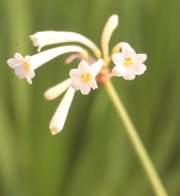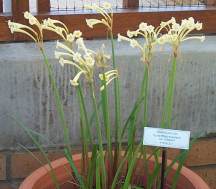Cyrtanthus mackenii
Cyrtanthus mackenii Hook.f.
Family: Amaryllidaceae
Common names: ifafa Lily
Introduction
This charming, sweetly scented bulb is long-flowering and easy to cultivate. It belongs to the genus Cyrtanthus which contains many beautiful species.

Cyrtanthus mackenii var. mackenii
Description
Description
The flowers of Cyrtanthus mackenii are long and narrow with recurved tips, and the leaves are narrowly lance-shaped. This species consists of two colour varieties: var. mackenii, which has pure white flowers, and var. cooperi, which has yellow or cream-coloured flowers. Adult plants reach about 400 mm high in full flower, and the individual flowers measure up to 50 mm long. C. mackenii has a very long flowering period, depending on the particular form being cultivated, extending from July to February.

Distribution and habitat
Distribution description
The var. mackenii occurs mainly in the southern parts of KwaZulu-Natal, and the var. cooperi occurs mainly in the eastern part of Eastern Cape, although the two varieties do overlap in certain areas.
Derivation of name and historical aspects
History
The genus name Cyrtanthus refers to the curved perianth tube of many of the species and is derived from the Greek kyrtos meaning curved and anthos meaning flower. The species name mackenii honours Mark J. McKen, a pioneer collector in KwaZulu-Natal, who became the first curator of the Durban Botanic Garden in 1851.
Several members of the genus are noted for their extremely rapid flowering response to natural bush fires, hence the common name, fire lily for several species.
Ecology
Ecology
The flowers of both varieties are sweetly scented and pollinated by night-flying moths.
Uses
Use
Cyrtanthus mackenii is not known to be used in traditional medicine but a decoction of the bulb of C. obliquus is used to treat chronic coughs.
Growing Cyrtanthus mackenii
Grow
Although all Cyrtanthus species can be cultivated in containers, due to the rather fastidious nature of many members of the genus, only a few are suited to the rigours of general garden cultivation. C. mackenii is certainly one of the easiest species to cultivate and ranks amongst relatively few others that can be successfully cultivated over an extended period in gardens in temperate climates.

Cyrtanthus mackenii is best planted in a growing medium that contains plenty of well-rotted organic matter. A suggested medium is equal parts of finely sifted compost, and coarse river sand or silica sand (swimming pool sand). Both colour varieties prefer a lightly shaded position, ideally receiving morning sun and afternoon shade, and like to be planted with the necks of their bulbs slightly exposed above soil level. The bulbs should be allowed to form large clumps and like to be left undisturbed for at least five years, until clumps become too thick and flowering performance diminishes. The bulbs require regular heavy watering about once every ten days throughout the year. Pots can be placed on semi-shaded balconies or verandahs, and when in flower can be brought indoors where the sweetly-scented blooms can be fully appreciated. C. mackenii is a good cut flower, each stem lasting up to ten days in the vase.
Propagation of Cyrtanthus mackenii is easy. Offsets (daughter bulbs) form rapidly and can be separated from the mother bulbs when large enough, in early spring. The perennial fleshy roots should not be allowed to dry out and the bulbs should be replanted immediately and watered well. Seeds can be sown in early spring in deep seed trays, in the same mixture recommended for adult bulbs (see above). Cover the thin, black, papery seeds with about 3-4 mm of sowing medium, and keep moist by watering with a fine rose. Germination of fresh seeds takes place within four weeks, and under ideal conditions, seedlings will often flower for the first time during their third season of growth.
The dreaded lily borer can be a problem during the summer months in southern Africa. Use a carbaryl-based insecticide for this problem. A systemic insecticide can be used if mealy bugs attack the bulbs and leaf bases.
References
- Duncan, G.D. 1989. Cyrtanthus. In N.M. Du Plessis & G.D. Duncan, Bulbous plants of southern Africa. Tafelberg, Cape Town.
- Duncan, G.D. 1990. Cyrtanthus — its horticultural potential, Part 1. Veld & Flora 76: 18-21.
- Duncan, G.D. 1990. Cyrtanthus — its horticultural potential, Part 2. Veld & Flora 76: 54-56.
- Reid, C. & Dyer, R.A. 1984. A review of the southern African species of Cyrtanthus. The American Plant Life Society, La Jolla, California.
Credits
Graham Duncan
Kirstenbosch National Botanical Garden
July 2002
Plant Attributes:
Plant Type: Bulb
SA Distribution: Eastern Cape, KwaZulu-Natal
Soil type: Sandy, Loam
Flowering season: Spring, Early Summer
PH: Acid, Neutral
Flower colour: White, Yellow, Orange
Aspect: Morning Sun (Semi Shade)
Gardening skill: Average
Special Features:
Horticultural zones










Rate this article
Article well written and informative
Rate this plant
Is this an interesting plant?
Login to add your Comment
Back to topNot registered yet? Click here to register.